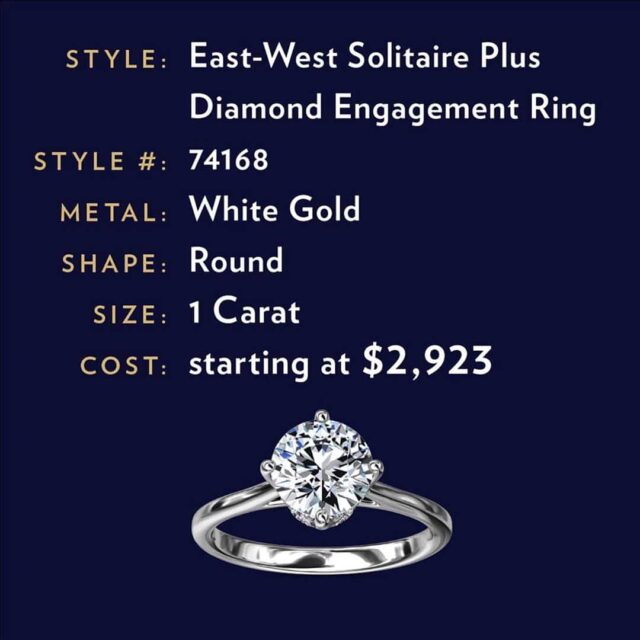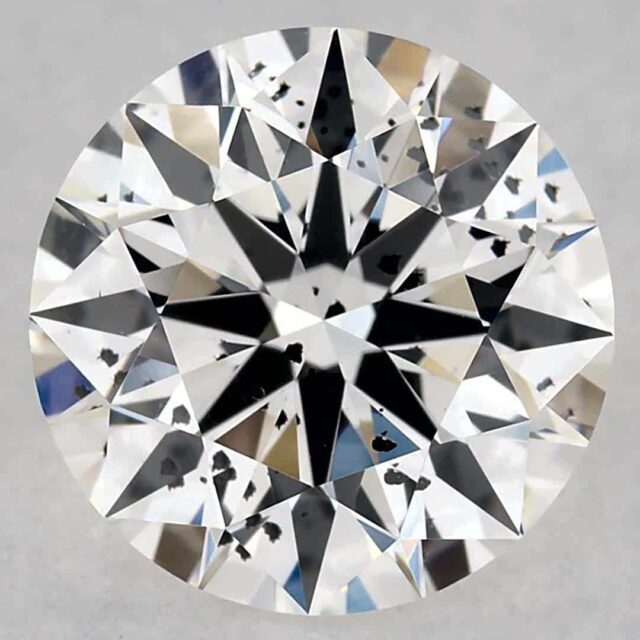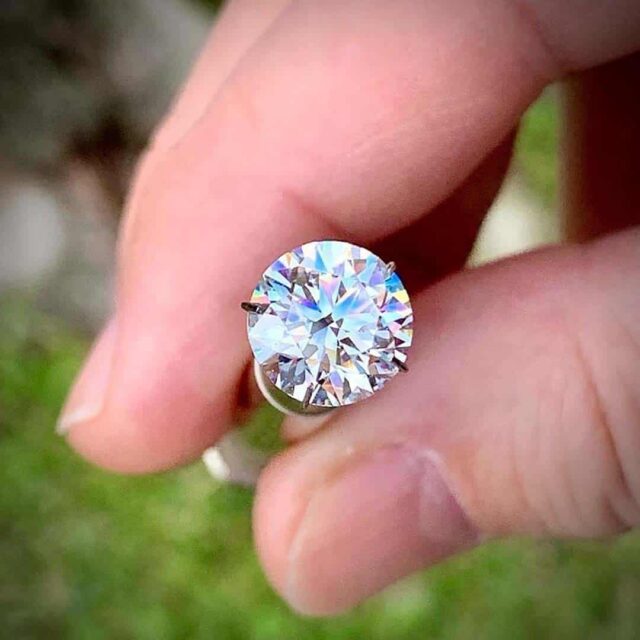I1 Clarity Diamonds contain inclusions that are readily and immediately visible without magnification; the abbreviation I-1 means Included to the 1st degree.
The I1 clarity grade represents the lower end of the spectrum. However, that does not mean that I-1 clarity diamonds look terrible.
It's just that included diamonds represent the lower end of the diamond clarity scale. It's also essential to know that each clarity grade represents a range or spectrum of inclusion.
Under those circumstances, there is a high, low, and mid-range within each clarity grade. In other words, in the world of diamond clarity grading, some specimens are better than others.
Conversely, knowing which I-1 clarity diamond to buy is not as easy as picking one that looks eye-clean. With that in mind, this tutorial intends to explain the intricacies of the clarity grade and teach you how to buy the best-performing diamond.
What Is an I1 Clarity Diamond?
In its most basic level, an I1 clarity diamond is included to the first degree. That means that the diamond contains a substantial amount of readily and immediately visible inclusions.
This 1.01 carat, F-color, I1 clarity, GIA Excellent round brilliant cut diamond from James Allen is a good example. In this case, the inclusions will be readily and immediately visible without magnification.
We do not recommend the diamond I1 clarity rating for engagement rings due to the inclusions' heavy concentration. In the first place, substantial clarity characteristics (flaws) can interfere with the light return.
Secondly, it seems like most people prefer that the diamond in their engagement ring be eye-clean. Conversely, it seems unlikely that an I-1 clarity diamond will be eye-clean given the high concentration of inclusions.
The GIA Diamond Clarity Scale:
The GIA Gem Trade Laboratory (GIA-GTL, GIA for short) sets the grading standard for the diamond industry. Arguably, that might be because they were the first organization to introduce an international grading standard.
Nevertheless, the majority of the industry grades according to GIA standards. In that case, most diamond clarity grades refer to the scale first introduced by the GIA in 1954.
It is essential to understand that the diamond clarity grade represents an absence of inclusions instead of a presence. In other words, the clarity grade describes the degree to which a diamond is not included.
Consequently, the same principle applies to diamond color grading. Under those circumstances, you can see the GIA clarity scale in a new light. After all, it's clear now why they use the words they do to describe each level of clarity.
The GIA Diamond Clarity Grades from Best to Worst:
As shown above, the I1 clarity grade describes the highest level of diamonds containing inclusions that cover most of the stone. In the same manner, diamonds that are I2 in clarity have a higher concentration of inclusions.
By the same standard, diamonds containing fewer inclusions will qualify for a higher clarity grade. Of course, the size, location, and extent of the clarity characteristics contribute to the final assessment. It is also worth noting that "the grade maker" might be a single more prominent inclusion.
Are I1 Clarity Diamonds Good Quality?
This 1.01 carat, H-color, I-1 clarity, GIA Excellent cut round diamond from James Allen might not seem that bad. After all, the feathers (fractures) responsible for the clarity grade are not that visible.
Keep that in mind because we're going to explore this diamond in more detail momentarily. For now, let's agree that beauty is in the eye of the beholder. Consequently, the same principle applies to diamond quality.
In other words, whether or not an I1 clarity is good quality is primarily a matter of perspective. The diamond clarity I1 does not seem like a good choice for an engagement ring from our perspective.
In the first place, you will be able to see the inclusions without magnification in all likelihood. Second, it is likely that the clarity characteristics within the diamond will present a durability risk.
In other words, I1 clarity diamonds represent the bottom of the barrel right and rank just above industrial grade. It also stands to reason that diamond prices will be less for lower clarity diamonds.
Potential I1 Clarity Durability Issues:
Given that diamond is the hardest mineral substance on earth, it might seem counterintuitive to worry about durability issues. Suffice to say that the keyword in that last sentence is the word mineral.
Consequently, there are many ways to chip and damage a diamond. We've also seen feathers spread like the ones in this 1.01 carat, H-color, I1 clarity, GIA Excellent round brilliant cut diamond from James Allen.
That is not to say that it will happen, but that we've seen it happen. We'll talk more about why that happens in the next section. However, please take a moment to study the extent of the inclusions before moving on.
In this case, the most significant feather is seen more thoroughly at a slight tilt. It's easy to see how far the fracture spreads into the stone's body from that perspective.
Do You Want Your Diamond to Be Eye-clean?
This 1.11 carat, I-1 clarity, GIA Excellent round brilliant cut diamond from James Allen is probably eye-clean. Consequently, this is perhaps the best-looking I1 clarity diamond that I've seen in 35+ years of experience.
Conversely, I'm not saying that the inclusions do not have a negative impact. The GIA diamond grading report's comment indicates that "the clarity grade is based on clouds that are not shown."
In that case, the intensity of cloud coverage within this diamond is extensive enough to justify the I1 clarity grade. If you look at the diamond closely, you will see that it has a cloudy appearance.
That means that the concentration of pinpoint size crystals within the diamond is interfering with the light return. Under those circumstances, it is unlikely that this diamond will exhibit that crisp, clean look that most people desire.
My Jeweler Says That This Is A Good I1 Clarity Diamond:
Perhaps that statement is valid from the perspective of your jeweler. However, there isn't a middle ground in our experience when it comes to lower clarity diamonds.
That is why we do recommend a minimum clarity of SI-1 and preferably VS-2 or higher. Consequently, we also disagree with the opinion that most SI1 clarity diamonds are eye-clean.
The reality is that we've always been able to find the inclusions within SI-1 clarity diamonds with a little bit of effort. In that case, the odds of finding a lower clarity diamond that looks better seems highly unlikely.
Although that may be true, we should probably explain the procedure for determining whether a diamond is eye-clean. Quite simply, an experienced grader will glance at the diamond from a distance of 9-12 inches.
If the inclusions are not readily and immediately visible, then the diamond is eye-clean. Now, tell me this, are you simply going to glance at the center stone in your engagement ring or subject it to scrutiny?
The Best Places to Buy Diamonds Online:
The majority of vendors we work with do not offer I-1 clarity diamonds because of the low quality. If you intend to buy a lower clarity grade, you can find them on James Allen and With Clarity.
However, we would prefer to help you choose a slightly smaller or warmer color diamond for the same price. In that case, we invite you to submit a search request via our free Diamond Concierge Service.
We'll even help you search for I1 clarity diamonds if that is what you want. But we'll feel like we're doing you a disservice because we've yet to see one that looks good.
As that may be, we're here to help you find the best-looking diamonds, not tell you what to buy. However, if you were to ask us, we recommend Black by Brian Gavin Diamonds above all else.








